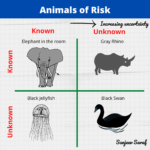We have been burning wood since days of the caveman. But did you know that wood can also explode?
Logs of wood will not explode but fine dust can lead to a fire and explosion. Let us see why.
As the size of combustible particle reduces there are two major factors that are affected:
1. Ignition Energy: With reducing particle size ignition energy reduces. For example, Minimum Ignition Energy (MIE) for wood dust can be as low as 7 mJ. If you were walking on a carpet, you would generate 15 mJ of static electricity. If the Caveman knew about effect of particle size on MIE, he would not have struggled igniting.
2. Rate of burning: As particle size decreases, the area available for combustion increases significantly. Going from a flat surface to a sphere increases exposed area by 3 times (approx.). For spherical particles, as the particle size decreases, the surface area to volume ratio increases (1/r). This increased surface area in turn increases rate of burning since now oxygen can reach particle from all directions. The enhanced combustion rate leads to increased flame speed (flame acceleration) and can lead to overpressures particularly in presence of semi-confinement.
For all practical purposes, we can assume that fine dust when dispersed will ignite. Any combustible dust (coal, wood, milk powder, rubber) has a potential for fire…how does fire lead to explosion? Explosion is a manifestation of external circumstances (confinement/semi-confinement) not merely the dust.
Here’s a video that demonstrates dust explosion of milk powder.






One Response
Great post Sanjeev! I’d like to include the importance of understanding bulk density which I feel could be analogous to vapor density. The heavier the product, the more of a hazardous accumulation could be present. Just my two cents..